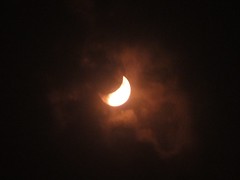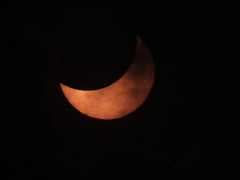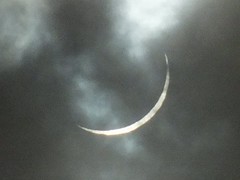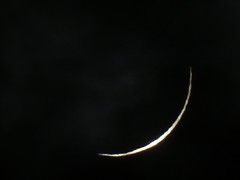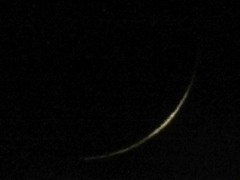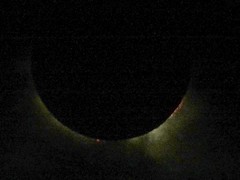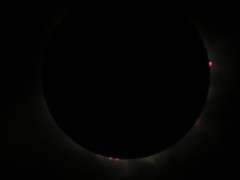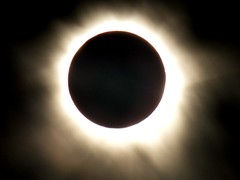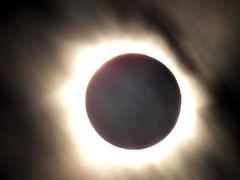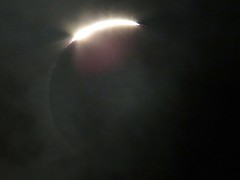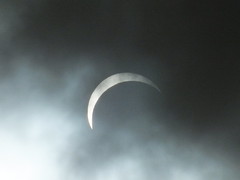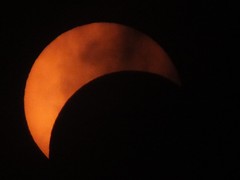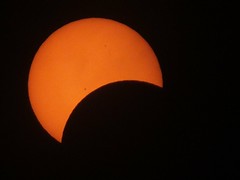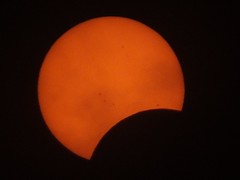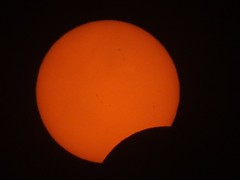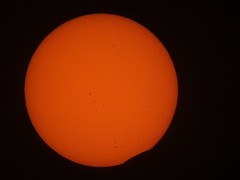Eclipse chasing, 14 Nov 2012
It’s funny that I should write several paragraphs discussing just 117 seconds of my life, but I think it deserves it.
The path of totality crossed the Pacific, but only made landfall in a couple of parts of Australia. Details from NASA.
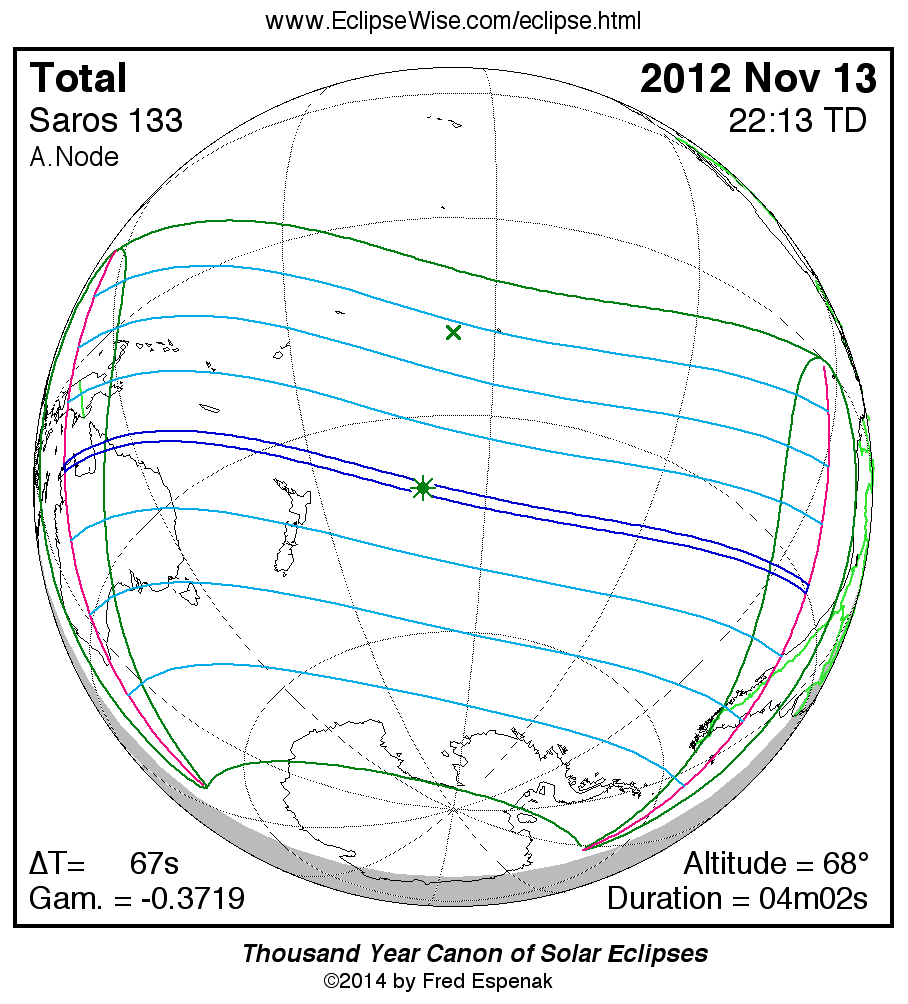
Living in New Zealand, we reckoned we couldn’t pass up the chance to see an eclipse in our own back yard, so to speak (though it was still a good 8 hours travel from home, door to door).
We were staying on the south side of Cairns. Dawn was at 05:35 local time (UTC+10). The eclipse was going to be partial between 05:44:48 and 07:40:23; totality would be between 06:38:38 and 06:40:35.
But there was, ah, a slight issue. Weather.
Meteorology
We knew there was a chance that we would be clouded out, which would have been gutting. Some of the more seasoned (and we suppose bigger-budget) eclipse chasers had chartered aircraft, boats, you name it. Apparently there were even forty hot-air balloons planning to be in the air at that time.
So the story of these nearly-two minutes begins a couple of days previously, as we pumped the ever obliging holiday park staff for information.
There were some 60,000 people expected to descend on the Cairns area on top of the regular population of 150k or so. Many of these were going to be on the Cairns esplanade itself or the beaches nearby, and the authorities expected there to be such a congestion problem that many streets and beaches were closed to traffic and parking extremely limited. Newspapers reported people planning to set up camp on the beaches from 10pm the night before to try and bag a good spot, but that didn’t appeal to us, with a night-time low of 21°C and killer velcro humidity.
So what were we going to do? The holiday park was on the south side of Cairns, with the Grey Peaks between us and the dawn. I knew the eclipse was going to be 14° above the horizon, or about eight fingers width with my arms outstretched. The ridge line was maybe half of that angle, which I confirmed the morning before. So we would see the eclipse there, provided we weren’t clouded out, and there would be no advantage to be gained by joining the throng on the esplanade and beaches unless it somehow afforded us a lesser chance of cloud cover, we particularly wanted to see the early parts of the partial eclipse, or we somehow felt like experiencing a huge crowd.
The Australian Bureau of Meteorology stated publicly that the chance of cloud cover at the time of totality was about 1 in 2. Not the world’s best odds. I read some online articles and learned that some chasers were planning to go to Mareeba, others to Townsville - both places pretty much guaranteeing a clear sky.
We discussed our options over dinner. They were stark.
- Stay put. 50% chance of cloud cover.
- Drive to Mareeba. It would be an hour’s drive inland in good conditions, probably worse tonight.
- Drive to Townsville. This was some 350km south and pretty much guaranteed a clear sky, but would only experience a 96% eclipse. In other words, it would be a consolation prize.
We agonised. Townsville was quickly eliminated, requiring three times as much driving as option 2, but for much poorer result. That left Mareeba. We hadn’t studied the map, didn’t know anything about the place; where could we park? where would have a good vantage? It was 7pm local time, 10pm by our body clocks, and we were already TIRED from the day’s excursion. So if we were going to make that run, we would have to either drive now, tired, on a dodgy gorge-side road - presumably spending the night in the car - or try to get a few hours kip, get moving at maybe 2am but risking both death on the road and getting caught up in traffic and missing it all.
The scenarios did not appeal. We concluded that we would stay put, get a reasonable night’s sleep, and see what we could see from the holiday park.
We set three alarms for 05:30. alea iacta est!
Day of the eclipse
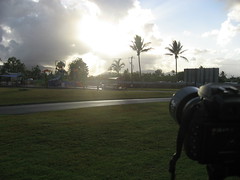
I woke a little before 5am and looked out the window. Stars! Not a huge number, I grant you, but it was not overcast. Could this be, hope of all hope, a sign that we might get the celestial display we wanted?
Tea and breakfast were quickly put together. Catching first contact was out of the question because of the Grey Peaks in the way, not that we cared, so we strolled down to the end of the park, with its mostly open view to the east, for about 6am. There was already a small crowd gathering, with various cameras, telescopes, solar filters and so on; we were graced by a couple of brief showers, as if Mother Nature wanted to remind us that She was in control.
With 21 minutes to go, you could feel the tension in the crowd. An awful lot of people were holding their breath. This is how it looked through the solar filter:
Darkness draws near
With three minutes to go, the clouds kept on moving. I realised that they would let me take the odd careful photo without the filter.
As totality approached, I experienced what’s called the primal fear. I really shivered. Some sort of species memory, I supposed, something to do with being afraid of the dark?
Eclipsed!
The crowd started to cheer as the umbra raced across us at several hundred metres per second. The lights went out. Here are several photos taken in quick succession with different exposure times; note the prominences, better visible on the shorter shots. (I used Fred Espenak’s exposure guide, which worked pretty well.)
Incredible. Unbelievable. Breathtaking (for the third time on this holiday). Raw. Primal. Majestic. Sheer. Celestial.
And then, as suddenly as it started, the umbra raced away from us at several hundred metres per second and we all fumbled to put our eclipse glasses back on and the filters onto the cameras. It was over. Sadly I didn’t manage to capture the diamond ring, nor Bailey’s beads, but there was less cloud in the way later, so I did get some better shots of the partial phase.
And that was that. One of Nature’s most spectacular displays, ticked off the bucket list.
Media

Some footage of clouds passing in front of the partially eclipsed sun. Watch for the bird at 0:09. (The link, in case you have embeds disabled.)
A wide-angle vista filmed on the B camera. This shows just how lucky we were with the cloud cover!
Future eclipses
(For full details, refer to the NASA eclipse site. Predictions by Fred Espenak, NASA’s GSFC.)
European residents will be interested in 2015 Mar 20, which will be 87% in London, over 92% in all of Scotland, and total in the Faeroes.- In the Americas, 2017 Aug 21 gives a path of totality across the continental US from Oregon to the Carolinas, and 2024 Apr 08 again from Mexico up to New Brunswick
- 2026 Aug 12 is Europe’s turn again, with totality from Greenland and Iceland down to Spain.
